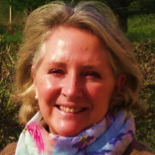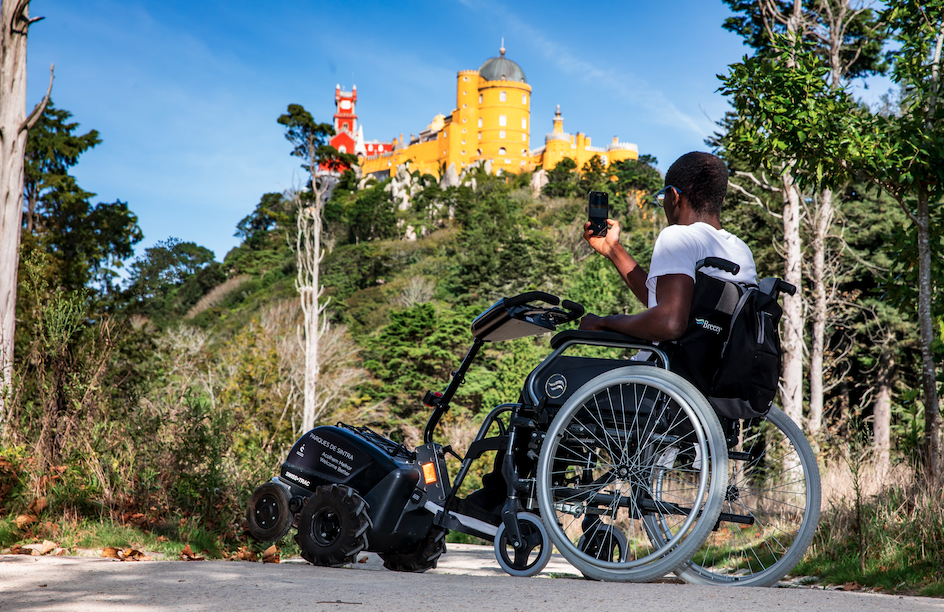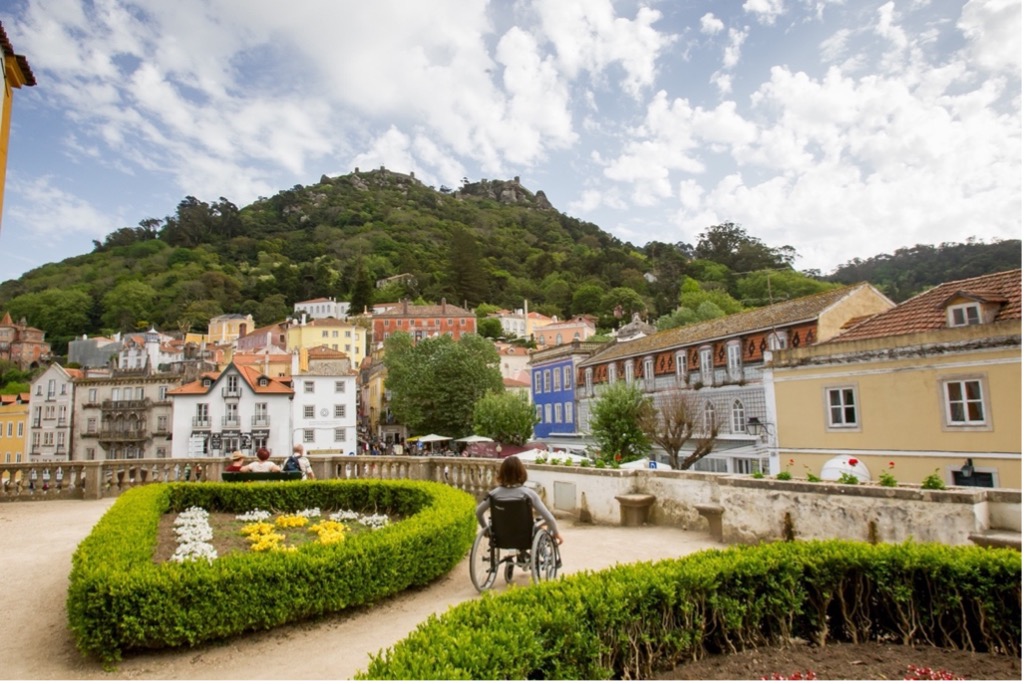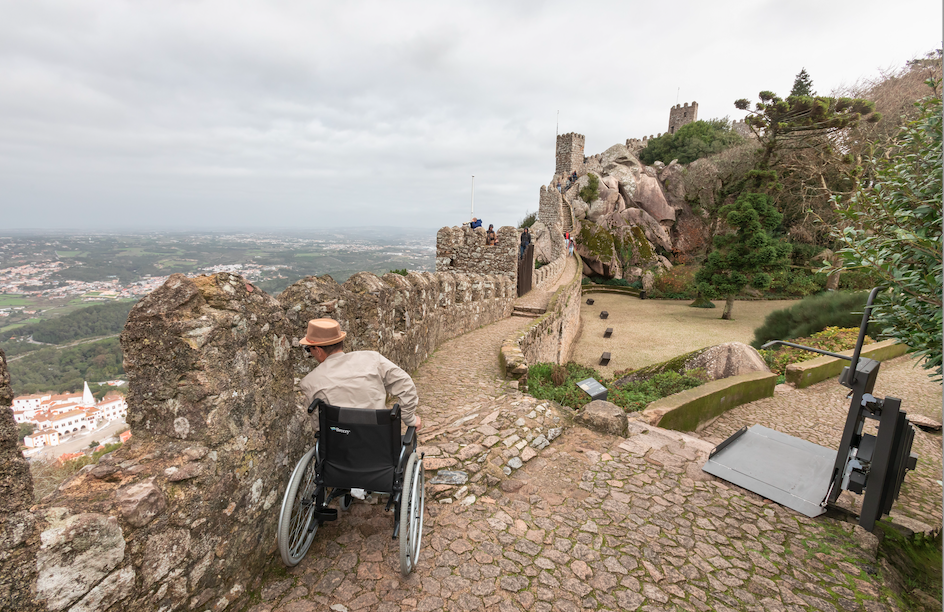Parques de Sintra Montes da Lua, Portugal
IMPACTOUR Good practices in accessibility for all.
 By Ana Garcia, IMPACTOUR Team, Board Member, European Network for Accessible Tourism and President of Accessible Portugal NGO. November 2021.
By Ana Garcia, IMPACTOUR Team, Board Member, European Network for Accessible Tourism and President of Accessible Portugal NGO. November 2021.

In the 19th century Sintra became the first centre of European Romantic architecture. Ferdinand II turned a ruined monastery into a castle where this new sensitivity was displayed in the use of Gothic, Indian, Moorish and Renaissance elements and in the creation of a park blending local and exotic species of trees.
Other fine dwellings, built along the same lines in the surrounding serra , created a unique combination of parks and gardens which influenced the development of landscape architecture throughout Europe.
The whole property is classified as a World Heritage Site by UNESCO. Being classified as a Cultural Landscape requires the adoption of several Statements from UNESCO related not only to the conservation of their proprieties but also their uses, as well as participation in different sessions and Conventions.
The Cultural Landscape of Parques de Sintra Montes da Lua (PSML or “Sintra”) in central Portugal is part of the National Natural Park of Sintra - Cascais and has been protected by national legislation since its classification in 1995.
Within its perimeter, there are numerous buildings classified as National Monuments - the highest level of legal protection - or Buildings with Public Interest, all of which are protected by specific Portuguese legislation introduced by the Ministry of Culture.
Efforts to improve the accessibility of this complex and challenging heritage site serve to ensure equitable access to cultural heritage for visitors with disabilities and those with other specific access requirements. As such, access improvements offer both direct and indirect benefits to the whole community. Planning what to preserve and what to adapt depends on the values of heritage and the effort to balance both these concepts. Conservation Policies consider the main principles and obligations, offering advice on decision making about the management and conservation of Cultural Landscapes. When dealing with such treasured sites as Cultural Landscapes, conservation is a priority. Therefore, responsible management entities, private or public, aim to protect the cultural, built, natural, historical values of those sites, which leads to the development of several conservation policies.
Nevertheless, professionals and researchers dealing with the PSML heritage sites are being increasingly challenged to fulfil a dual, and seemingly conflicting, mission: to preserve and sustain natural and cultural heritage for future generations under the scope of conservation policies, while simultaneously providing for the well-being and autonomy of visitors with specific accessibility requirements.

The “Parks of Sintra Welcome Better” project, launched in 2013, focused on three different dimensions of access:
- Physically: improving mobility conditions and providing an autonomous and safe visit to everyone, with physical adaptations to the outdoor and interior environments and the acquisition of new equipment.
- Information: improving communication and the available information irrespective of visitor characteristics.
- Services: providing more and better services catering to diversified audiences, including people with disabilities, and guaranteeing a more effective dissemination of cultural identity values.
Where it was not possible to make physical alterations according to the legal accessibility requirements, professionals must implement “non-standardised solutions”, i.e., solutions that are not suggested by normative documents but creatively adapted from them to a specific site.
PSML had external support for the project in the form of know-how and technical assistance from several associations of national relevance in the disability context, namely: Associação Salvador - Salvador Association (physical accessibility); Associação Portuguesa de Surdos (Portuguese Association for the Deaf); ACAPO Association of the Blind and Partially-Sighted of Portugal and Acesso Cultura (Access Culture – for better culture integration and cultural information). Additionally, PSML, is also part of the European Network for Accessible Tourism (ENAT) in order to have a greater correlation with other European Institutions and to make part of an even greater team that strives to have a more accessible and inclusive European continent.
PSML explored possible strategies and actions for improving accessibility through a series of activities with experts and stakeholders. It was determined that several elements are critical to give an effective and efficient practical response to the balance between conservation and adaptation, these being: 1. Reversibility of infrastructure works, 2. Consideration for the conservation principles; 3. Adaptive and creative solutions being integral to the project; 4. Multidisciplinary team; 5. Researchers; 6. Consultation and 7. Evaluation.
In consideration of these points the project team was able to predict the consequences of each action by assessing both the positive and the negative impacts on the heritage. Decision-making tools can give a valuable contribution when deciding which interventions can be made and how to reduce possible negative impacts.
It is important to add that the staff training is a complex and very important part of the process as the inclusive services cannot be dissociated from the physical accessibility. When an access programme is implemented, the managers have to ensure they have the right mix of well-trained human resources prepared to receive people with disabilities, in order to make available all the equipment and to be able to provide appropriate information and support to all visitors. An integrated accessibility concept comprising physical access, access to services and to information is needed to allow the correct implementation of better access conditions.

The implementation of the project had several contributions from several internal and external teams. Internally, from PSML, the following departments were involved in the project: the Board of Directors, the Technical Division for Natural Heritage (Landscape Architects, Forest Engineers, Biologists, Health and Safety Managers); the Technical Division for Built Heritage (Civil Architects, Civil Engineers, the Conservation and Restoration team and Archaeologist), the Directors of the National Palaces and Monuments, the Accessibility Team (responsible for the implementation of the project), the Security and Visitors’ Support ( which includes all the workers responsible for welcoming the public), Historical research team, Communication and promotion department, and the Human Resources Department, Educational Service Department. As mentioned above, the external associations also contributed to a more successful choice of solutions through their participation.
The company’s inclusive employment practices also do not discriminate against workers from different backgrounds or living with various conditions. Employment processes are designed and monitored at the recruitment and selection stage to ensure that discriminatory barriers to those that wish to apply to work at the company are removed. Additionally, through the company's social responsibility policy, service contracts are established for private institutions of social solidarity - the CECD - Mira Sintra. Those service contracts establish that the maintenance of the Park of Monserrate and the Park of Pena is ensured by teams of marginalised or vulnerable people with difficulties of integration or with no access to employment under conditions of equal opportunities. This policy promotes measures of positive discrimination, especially those related to protected employment and vocational training. These services are fruitful due to the possibility of individual employment by PSML if there is a positive development after the period of time covered by the integration programme.
While the ‘Parks of Sintra Welcome Better’ project was launched in 2013 and the external financing from the National Tourism Authority ended in December 2016, PSML continues to strive to be an example of best practice in accessible tourism and is constantly re-evaluating accessibility conditions and improving the existing conditions to develop more inclusive solutions.
Acknowledgements
Photos for this article by Luis Duarte, reproduced by kind permission of Parques de Sintra – Monte da Lua S.A.
Parques de Sintra – Monte da Lua S.A. (PSML) is a publicly owned company created to bring together the main institutions responsible for the protection, restoration, and conservation of the extraordinary Cultural Landscape of Sintra. Since its creation, the government entrusted to PSML, for management, the main public properties located in the World Heritage site: the Parks and the National Palace of Pena, the Park and Palace of Monserrate; the Chalet and Gardens of the Countess of Edla; the Moorish Castle; the Capuchos Convent; the Quinta da Abelheira; and several adjacent walled forests. In 2012, PSML also became responsible for the National Palace of Sintra; the National Palace and Gardens of Queluz; the Portuguese School of Equestrian Art, based in Queluz, and the riding ring Henrique Calado, in Lisbon, where the School regularly performs. Visit: https://www.parquesdesintra.pt/
![]() The IMPACTOUR project has received funding from the European Union’s Horizon 2020 research and innovation programme under grant agreement No. 87074.
The IMPACTOUR project has received funding from the European Union’s Horizon 2020 research and innovation programme under grant agreement No. 87074.
Download this article in PDF format from the link below.